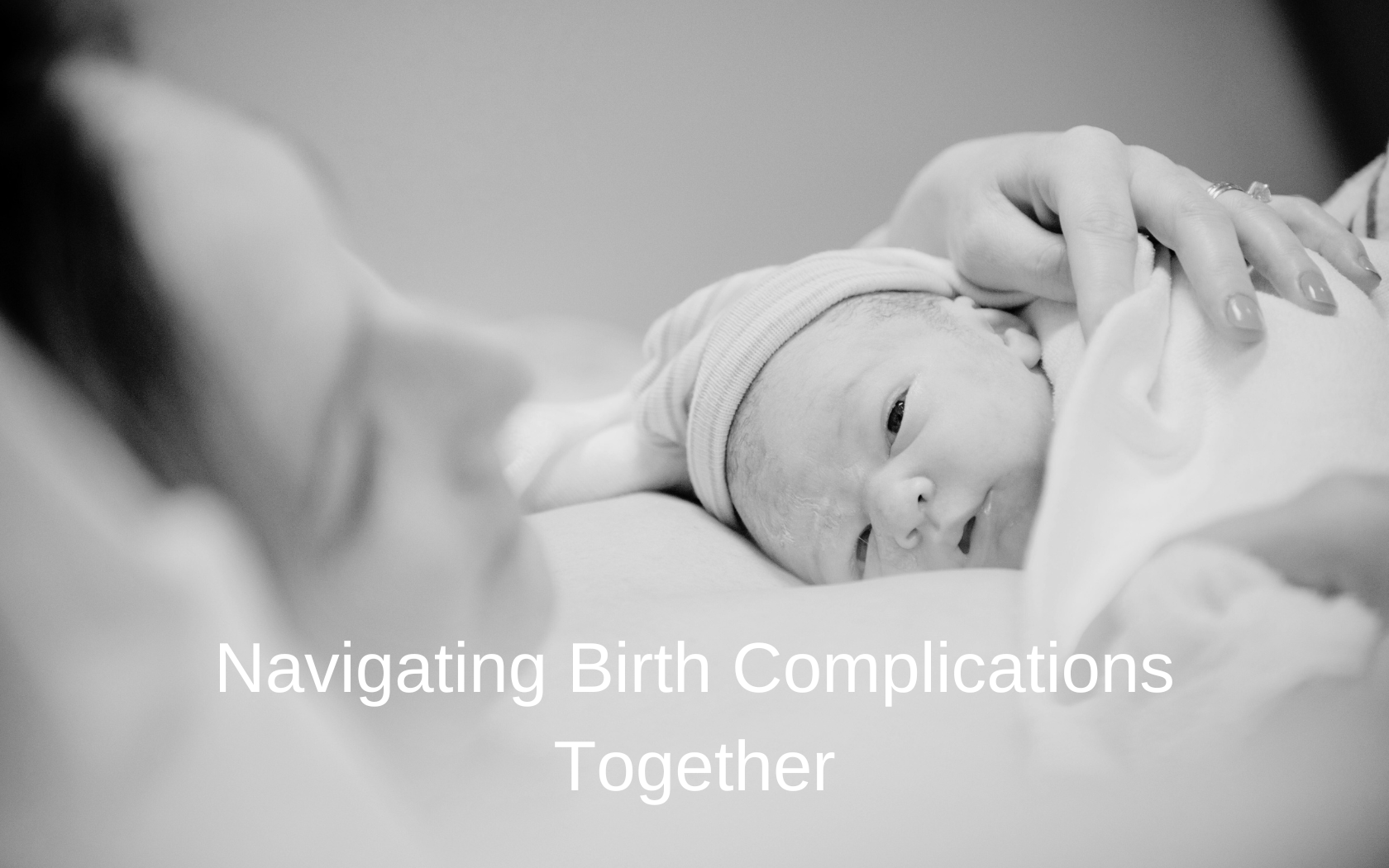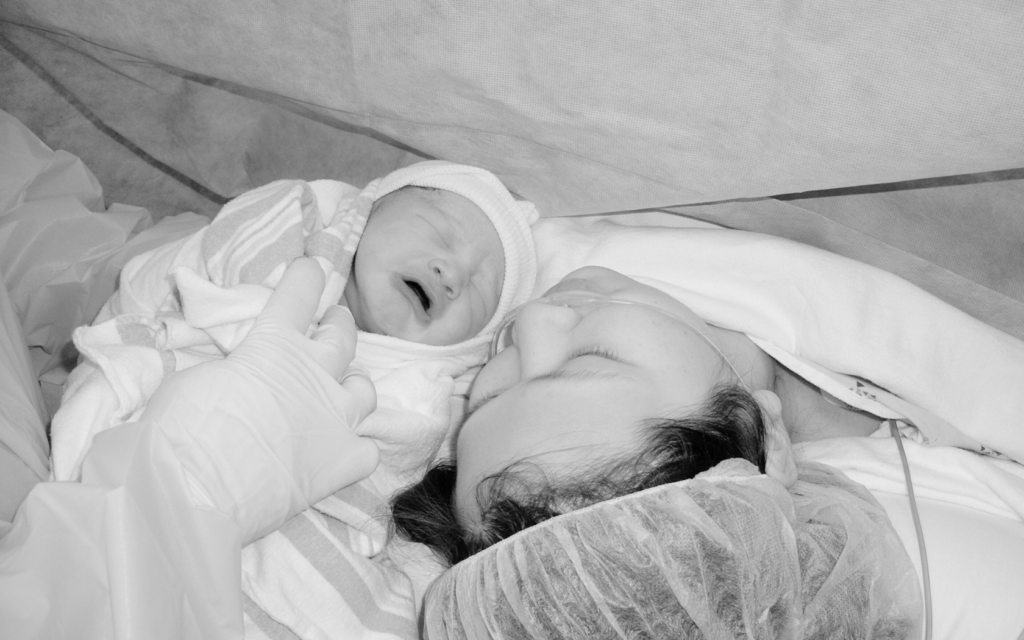Every great adventure in life comes with risks–including childbirth. That’s what Erica Berg took away from her encounter with one of the most dangerous childbirth complications to exist. Erica experienced uterine rupture, a life-threatening delivery complication.
Thankfully, both Erica and her baby escaped unscathed from the ordeal. But some mothers and babies aren’t so lucky. For them, delivery complications result in birth injuries.
Below, we’ll identify and explain the most dangerous childbirth complications. If you have experienced any of these, and your baby developed a birth injury, it’s possible your medical provider mishandled your treatment. If your child sustained harm as a result of negligence, you have the right to take legal action. Contact us now to find out if you qualify!

Erica’s Delivery Complication Story
It all started with an explosion–inside Erica’s stomach. Unlike the pain of the contractions she had felt in previous hours, this was extreme and unrelenting.
Erica was experiencing uterine rupture, one of the most dangerous childbirth complications ever. Lucky for Erica, her medical team noticed right away that something had gone wrong. They rushed her to the operating room, where they administered anesthetic to numb her body. After giving Erica oxygen, they pulled out her limp, blue baby, whisking him away to neonatal intensive care.
Later that day, Erica couldn’t believe she and her baby were alive. She knew that uterine rupture causes a lot of blood loss for mothers. Babies often don’t survive because the placenta can detach and deprive them of blood. But thanks to the swift action of her medical team, Erica and her baby suffered no long-term effects.

Top 3 Most Dangerous Childbirth Complications
What exactly happened to Erica? Why are some delivery complications so dangerous? Erica experienced one of the top 3 most life-threatening birth issues: uterine rupture. Many researchers consider it the most dangerous complication.
The three most serious delivery complications are:
- Uterine rupture
- Umbilical cord prolapse
- Shoulder dystocia
Remember, while it’s important to know the warning signs, the conditions above are rare.
Let’s dive into a brief explanation of each:
Uterine Rupture
The uterus is the organ in which the baby grows during pregnancy. Uterine rupture is when the wall of the uterus tears or breaks open. This can cause a lot of bleeding, which can lead to organ failure in the mother. The baby’s life is at risk too, because they may not get enough blood and oxygen. Also, the baby might be born too soon. They may struggle with additional issues because of prematurity.
Causes of uterine rupture include:
- Previous uterine surgery (like a C-section).
- Overdistension of the uterus (when it stretches too much because of a big baby or too much amniotic fluid).
- Other medical conditions and unknown causes.
Treatment includes performing surgery to repair the torn uterus and providing oxygen to both mother and baby.
Umbilical Cord Prolapse
Umbilical cord prolapse is when the umbilical cord slips out before the baby is born. When the baby’s head isn’t firmly in place in the birth canal, there’s a risk that the umbilical cord can prolapse. This is a dangerous delivery complication because it can squeeze or compress the cord, cutting off the baby’s oxygen supply. Oxygen deprivation can lead to brain damage or even death.
Treatment usually involves performing an emergency C-section (a surgical delivery) to get the baby out quickly and safely. This can help prevent harm to the baby.
Shoulder Dystocia
Sometimes a baby’s shoulders get stuck behind the mother’s pelvic bone during delivery. This is called shoulder dystocia. The medical team must take special measures to deliver the baby. Otherwise, the baby can sustain birth injuries, including:
- Brachial plexus injury (damage to the nerves controlling the arm and hand muscles)
- Oxygen deprivation, which can lead to brain injuries
- Breathing issues from inhaling meconium (first stool)
To prevent injuries, doctors might use the McRoberts maneuver (repositioning the mother and applying pressure to her abdomen). At times, the situation requires a C-section.
Other Dangerous Delivery Complications
- Chorioamnionitis. This is an infection or inflammation of the membranes surrounding the baby (amnion) and the inside of the uterus (chorion) during pregnancy. The reason why chorioamnionitis is one of the most dangerous childbirth complications is because it can affect the amount of oxygen and nutrients a baby receives. It can cause brain damage and lead to conditions like cerebral palsy.
- Fetal Macrosomia. When the baby is large at birth, weighing over 8 pounds, 13 ounces, vaginal delivery may not be safe. These babies may get stuck in the birth canal.
- Infections. Maternal infections that can cause delivery complications include Group B Streptococcus (GBS), Herpes simplex virus (HSV), Human Immunodeficiency Virus (HIV), and Syphilis)

Think You’re a Victim of Malpractice?
If you’re grappling with the aftermath of a childbirth complication, connecting with a medical malpractice attorney can be a game-changer. A specialized birth injury lawyer can help you untangle the complexities of the situation. By reaching out to them, you’re not just seeking justice; you’re giving yourself a shot at the support and compensation you might need to move forward. Don’t hesitate—your well-being matters and a good attorney can be your advocate in navigating these tough circumstances. Please reach out to us if you need assistance as our firm specializes in birth injury law. We have over 60 years of experience and have helped our clients recover millions. Contact us by clicking here.
Delivery Complication FAQs
Research shows that postpartum depression (PPD) is the number one childbirth complication. About 50-60% of mothers experience it in the weeks following birth. Postpartum depression is when a mom feels sad, anxious, and overwhelmed after having a baby. It’s different from the normal “baby blues” and can last longer.
Although it’s not one of the most dangerous childbirth complications, PPD requires medical attention. Depression can lead mothers to hurt themselves or their babies.
Common complications during labor and delivery include:
– Water breaking early.
– Abnormal heart rate of the baby.
– Shoulder dystocia.
– Labor that doesn’t progress.
– Excessive bleeding
– Perineal tears
A difficult birth is defined as labor that goes on for over 18 hours. This can put both the mother and the baby under a lot of stress.
It can also refer to a situation where the circumstances make it harder or riskier for the mother or baby. Examples include:
Breech Presentation: The baby is positioned feet-first or bottom-down instead of head-down.
Multiple Births: Twins or other multiples can present challenges during birth.
Large Baby (Macrosomia): The baby is larger than average.
Obstructed Labor: There’s an obstacle that prevents the baby from moving down the birth canal, such as shoulder dystocia.
Maternal Health Conditions: The mother has pre-existing health conditions like high blood pressure, diabetes, or infections.
Induced or Augmented Labor: The use of medications or interventions to start or speed up labor can increase the chances of complications.
Previous Cesarean Section: Attempting a vaginal birth after a prior C-section (VBAC) can carry risks.
Serious delivery complications: The mother has a dangerous condition like placenta previa, chorioamnionitis, or preeclampsia.
Some of the most common pregnancy complications include, but aren’t limited to:
Miscarriage (Losing the baby before 20 weeks of pregnancy)
Ectopic pregnancy (When the fetus implants in a fallopian tube or elsewhere outside of the uterus)
Preterm labor (Giving birth before 37 weeks of gestation)
Low birth weight (The baby weighs less than it should at birth).
High blood pressure (This can make it hard for blood to reach the fetus.)
Infections (Infections in the mother can lead to serious delivery complications if they go untreated.)
There are 15 major danger signs of pregnancy, according to the CDC. They are as follows:
– Headache that won’t go away
– Dizziness or fainting
– Trouble breathing
– Fever of 100.4 or more
– Vision changes
– Severe nausea and vomiting
– Baby moves less or not at all during pregnancy
– Extreme swelling in hands and face
– Severe abdominal pain that won’t go away
– Chest pain or racing heartbeat
– Extreme tiredness
– Severe swelling, redness, and pain in the arm or leg
– Thoughts about harming yourself or your baby
– Leaking fluid or blood during pregnancy
– Abnormal amount of discharge/blood after delivery
If you have any of these symptoms during pregnancy or after delivery, seek medical help right away. You may be experiencing a dangerous childbirth complication.




